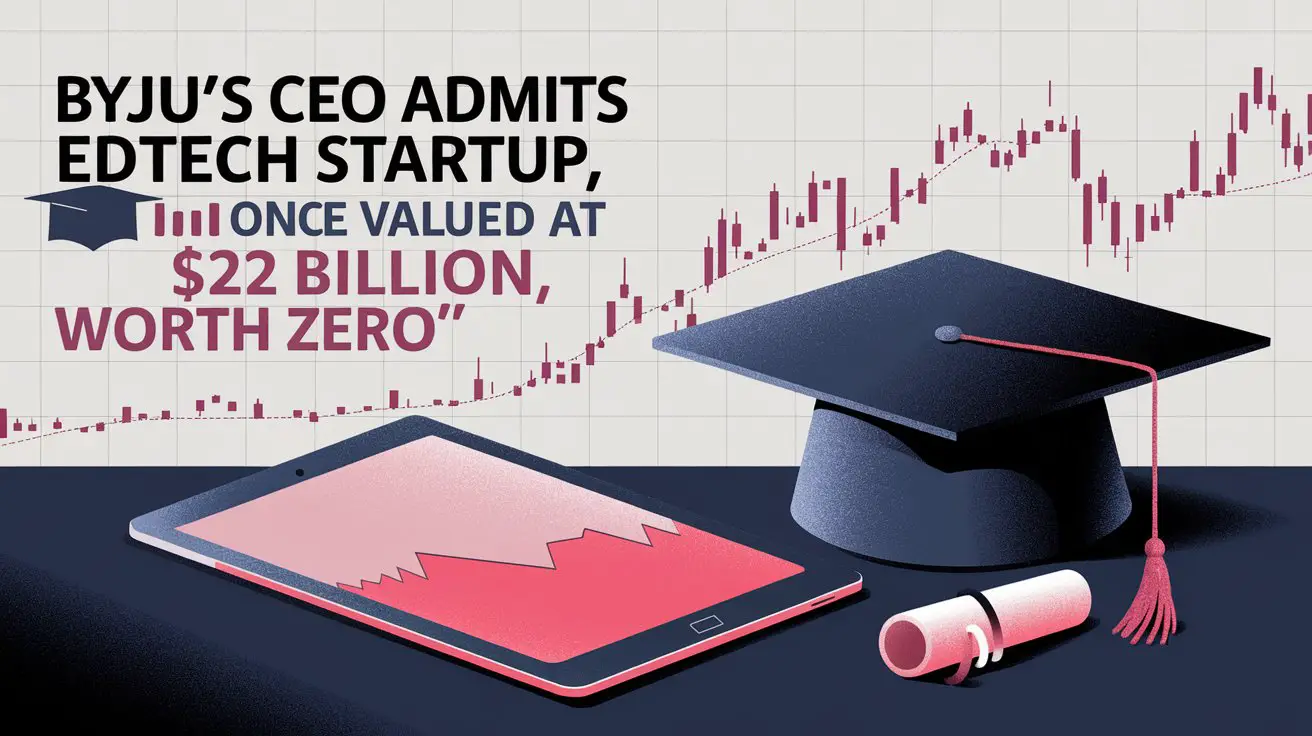In a dramatic and unexpected turn of events, Byju’s, once heralded as one of the most valuable edtech startups in the world, has seen its valuation plummet to the point where its founder and CEO, Byju Raveendran, admitted that the company is now “worth zero.” This admission sent shockwaves across the global startup ecosystem, particularly in the tech and education sectors, where Byju’s was once a poster child for success in digital learning.
This significant decline comes after years of rapid growth, ambitious acquisitions, and high valuations. At its peak, Byju’s boasted a valuation of $22 billion, positioning it as a leader in the global edtech market. Its innovative approach to online learning and aggressive expansion plans initially garnered widespread praise and investment. However, the company’s meteoric rise has been followed by an equally spectacular fall, as it grapples with a myriad of issues, from financial struggles to regulatory scrutiny.
This article will explore the factors that contributed to Byju’s staggering downfall, how the edtech landscape is changing, and what the future might hold for the once-mighty startup.
The Rise of Byju’s: A Success Story
Founded in 2011 by Byju Raveendran, Byju’s was conceived as an online learning platform that offered engaging and interactive courses for students. Initially, the company focused on test preparation for competitive exams in India, such as the Indian Institutes of Technology (IIT) entrance exams, but it quickly expanded into a broader K-12 education platform. By leveraging a mobile-first approach, Byju’s was able to capitalize on the growing penetration of smartphones and internet access in India.
Byju’s success stemmed largely from its ability to combine technology and education in a way that resonated with both students and parents. The platform used rich multimedia content, personalized learning, and gamification to make learning more engaging. This unique approach helped the company rapidly scale and attract millions of users, particularly in India’s growing middle-class population.
As the edtech sector gained traction globally, Byju’s quickly expanded into international markets, acquiring companies like Osmo, Epic, and WhiteHat Jr. to strengthen its product portfolio and reach. These acquisitions allowed Byju’s to enter new markets, particularly in the U.S., and diversify its offerings to include coding, digital learning tools, and early education content.
Record-Breaking Valuation
Byju’s success in scaling its user base and expanding its reach caught the attention of investors. Over the years, the company secured funding from top venture capital firms, including Sequoia Capital, Tiger Global, and Silver Lake Partners. These investors believed in Byju’s potential to disrupt the traditional education model and revolutionize how students learn in the digital age.
As funding poured in, Byju’s valuation skyrocketed. The company quickly became a “unicorn” and was eventually valued at $22 billion, making it the most valuable edtech startup in the world. This meteoric rise was seen as a triumph not only for Byju’s but also for the Indian startup ecosystem, which had produced several high-profile tech companies in recent years.
The company’s financial success was further underscored by its high-profile partnerships, including collaborations with Disney and sponsorship deals with major sports teams like India’s national cricket team. These moves cemented Byju’s position as a household name and a major player in both education and entertainment.
The Fall: From Billions to ‘Worth Zero’
Despite Byju’s incredible rise, trouble began brewing behind the scenes. The company’s aggressive expansion strategy, while initially lauded, led to several financial and operational issues. Byju’s pursued a series of high-profile acquisitions, spending billions of dollars to expand its portfolio and enter new markets. However, many of these acquisitions struggled to generate the expected returns, leading to mounting financial losses.
At the same time, the company faced increasing scrutiny from regulators and investors. Concerns emerged about the transparency of Byju’s financial reporting and the sustainability of its business model. Reports of high-pressure sales tactics and misleading advertising practices further damaged the company’s reputation, leading to customer complaints and regulatory probes.
The edtech sector itself also began to face challenges. The COVID-19 pandemic initially created a surge in demand for online learning platforms, but as schools and universities reopened, the demand for remote learning products began to wane. Many edtech companies, including Byju’s, struggled to adapt to the post-pandemic environment, where the hybrid model of education gained more traction. This shift led to a significant reduction in Byju’s user growth, exacerbating its financial difficulties.
Adding to Byju’s woes were difficulties in servicing its debt obligations. The company had borrowed heavily to finance its expansion, but as revenue growth slowed, meeting these financial commitments became more challenging. Some analysts have suggested that the company’s aggressive borrowing strategy was unsustainable, leading to a liquidity crunch.
Faced with mounting debt, slowing growth, and regulatory scrutiny, Byju’s found itself in a precarious financial position. In a candid interview, CEO Byju Raveendran admitted that the company’s valuation had dropped to zero, a stunning reversal for a company that was once a global leader in edtech.
Key Factors Behind Byju’s Downfall
Byju’s collapse can be attributed to a combination of internal and external factors. While the company’s initial success was driven by its innovative product offering and rapid expansion, several missteps contributed to its downfall.
Overexpansion and Mismanagement
One of the most significant factors behind Byju’s struggles was its aggressive acquisition strategy. The company acquired several businesses across different sectors, but many of these acquisitions failed to deliver the expected returns. For example, the purchase of WhiteHat Jr., a coding education platform, was marred by controversy over misleading advertising and high-pressure sales tactics, damaging the company’s brand.
Moreover, Byju’s rapid international expansion stretched its resources thin, leading to operational inefficiencies and mismanagement. The company struggled to integrate its acquisitions into a cohesive business model, leading to mounting losses.
Regulatory Scrutiny
Byju’s faced increased scrutiny from regulators, particularly in India, where the company was accused of using unethical sales practices to push its products. Reports emerged that the company was pressuring parents to sign up for expensive subscription plans, often without fully understanding the financial implications. These practices led to a backlash from customers and prompted investigations by consumer protection agencies.
The company also faced challenges related to its financial reporting practices. Investors and regulators raised concerns about the transparency of Byju’s financial statements, leading to questions about the company’s true financial health.
Post-Pandemic Shift in Education
The COVID-19 pandemic created a massive surge in demand for online learning platforms as schools around the world shifted to remote learning. Byju’s was one of the beneficiaries of this trend, as millions of students turned to its platform for educational content. However, as the pandemic subsided and schools reopened, the demand for online learning began to decline.
This shift caught many edtech companies off guard, including Byju’s. The company struggled to maintain its growth momentum in a post-pandemic world where hybrid and in-person learning models regained popularity.
What’s Next for Byju’s?
Byju’s dramatic fall raises questions about the future of the company and the edtech sector as a whole. While the company is currently grappling with significant challenges, it’s worth noting that Byju’s still has a large and loyal user base, particularly in India. The company’s core product offering—digital learning for students—remains relevant, and there is still demand for high-quality online education.
However, to survive and potentially recover from its current crisis, Byju’s will need to make significant changes to its business model and strategy. This may include streamlining operations, divesting underperforming assets, and improving its financial transparency. Additionally, the company will need to regain the trust of its customers, investors, and regulators by addressing the concerns that have plagued its reputation.
Byju’s also faces increasing competition from both established players and new entrants in the edtech space. Companies like Unacademy, Vedantu, and Khan Academy are gaining traction in the digital education market, and Byju’s will need to innovate and differentiate itself to stay competitive.
Conclusion: A Cautionary Tale for the Edtech Sector
The story of Byju’s rise and fall serves as a cautionary tale for the edtech sector and the broader startup ecosystem. While rapid growth and high valuations can create excitement and attract investment, they can also mask underlying challenges and vulnerabilities. In Byju’s case, the company’s aggressive expansion strategy, coupled with mismanagement and regulatory issues, ultimately led to its downfall.
For other startups in the edtech space, Byju’s serves as a reminder of the importance of sustainable growth, ethical business practices, and transparency. As the sector continues to evolve, companies that prioritize these values will be better positioned to navigate the challenges of a rapidly changing education landscape.
Byju’s may have fallen from its peak valuation, but the lessons from its journey will continue to resonate throughout the tech world for years to come.





